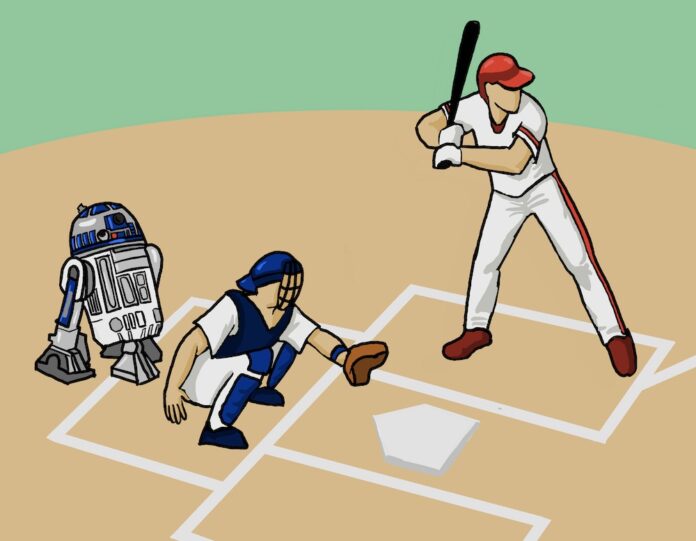It was Oct. 14, 9:37 p.m. on that fateful Thursday night. There I was in the Bell-Young common room, eyes glued to the TV, hands on my head, jaw-dropped and speechless as LA natives screamed and celebrated in ecstasy around me.
Baseball is a game of unpredictability where any call, catch, hit, out and even pitch can greatly turn the tide. Human error has an exciting place on the baseball field, but not when it comes from the official behind the base. As a self-proclaimed baseball aficionado and recent Ohtani enthusiast, I’m tired of watching umpires make incorrect and unreviewable judgment calls that cost teams games and championships — and my sanity. What happened that Thursday night impacted the first two and almost lost the latter.
The Dodgers and the Giants were battling out “the most important game in the history of their rivalry” according to Hall of Fame broadcaster Vin Scully. The Giants were down to their last hope with two outs, one on and a 0-2 count. Dodgers pitcher and three-time Cy Young Award winner Max Scherzer delivered an 87 mph slider low and outside to Giants hitter Wilmer Flores, who started to swing but stopped and quickly pulled back his bat. Was it a swing-and-miss strike or a check-swing? All eyes were on first base umpire Gabe Morales to make the judgment call.
Morales raised his right arm and formed a fist: out. The Dodgers stormed the field and Scherzer screamed like a mad man. Strike three, three outs, game over.
As if to taunt everyone watching the game, the final deciding moment was replayed in slow motion from every possible angle. The painful slow-mos revealed a devastating truth: Morales blew the final call. Flores did not swing and miss, he “checked” his swing. Booing could be heard throughout the stadium and angry fans threw beer onto the field.
“That umpire has his phone on silent and is sleeping with one eye open tonight,” I typed. Send Tweet. Not only was Bell-Young in chaos, but social media was too. “You cannot end the Giants’ 107-win season on a check swing that wasn’t a swing,” tweeted sports journalist Jared Carrabis. This incredibly important game had been concluded by an incorrect judgment call that couldn’t be reviewed, abruptly ending the playoffs run for the team with the best record in the MLB.
Sure, Flores was previously 0-17 against Scherzer — but that doesn’t justify the end. I’m not defending Flores, but rather the unpredictable game of baseball as a whole and the endless outcomes that were possible that night.
I stand by two major and controversial changes that can be made to Major League Baseball (MLB) which will avoid devastating calls such as “The Check Swing Call Heard ‘Round the World‘” and lessen the number of fans screaming at the electronic strike zone on their TV or MLB app. Yes, I am one of these people and no, screaming doesn’t help.
Proposition number one: make check-swing calls reviewable.
Not explicitly defined in the MLB rulebook, a check-swing is one of those “you know it when you see it” type of calls. Unfortunately, Morales did not know it or see it. A call made in a split-second, purely based on judgment and seen from 105 feet away is prone to human error and needs to be reviewable.
But there is another type of call that reeks of human error: ball and strikes. Even more so than check-swing calls, incorrect ball-strike decisions leave fans and players with a bad, no, terrible taste in their mouth.
Some might argue that human error from the umpires is an important part of the game. Tell that to the 34,294 missed ball-strike calls in 2018. These “small mistakes” add up and clearly have their consequences. Blown calls hurt both the pitcher and the batter. Through Aug. 1, umpire Edwin Moscoso’s 108 blown strike calls cost pitchers an estimated 16 earned runs. On the other hand, umpire Doug Eddings’s 113 incorrect ball calls saved pitchers an estimated 18 runs. Umpires can be inconsistent with their strike zones, a flaw that an electronic strike zone and a robot umpire can avoid.
Yes, I am for robot umps. Since I’ve already begun to dig my own grave with that statement, bring me a backhoe because I’m about to dig a trench.
Many who are against robot umps are supporters of pitch framing, which is when the catchers receive the ball closer to the strike zone, influencing balls to appear as strikes. Some worry that robot umps will eliminate “the art of pitch framing.” Well, to call it an “art” is a stretch; more accurately, pitch framing is a skill used to trick a professional umpire into making an incorrect call. It hurts the batters and the integrity of the game.
“Batters train for years to identify what is a strike and what is a ball. So, when they, in a fraction of a second, successfully identify a ball only to hear the umpire call strike because the catcher “stole it“, they have a right to be frustrated,” wrote Sports Illustrator journalist Jared Martin.
With a virtual graphic, the electronic strike zone is visible on TV every time I watch a game. Fans can plainly see if the pitch was a ball or strike. When we can see blatant errors being committed in real-time, 34,294 times a year, the game loses credibility and fairness. Nothing frustrates me — and Joe Maddon — more than a blown strike three call with runners on. There is a solution, all we have to do is implement it.
America’s pastime may be a traditional and beloved part of our nation, but as America modernizes, the game must too.
![]()




































